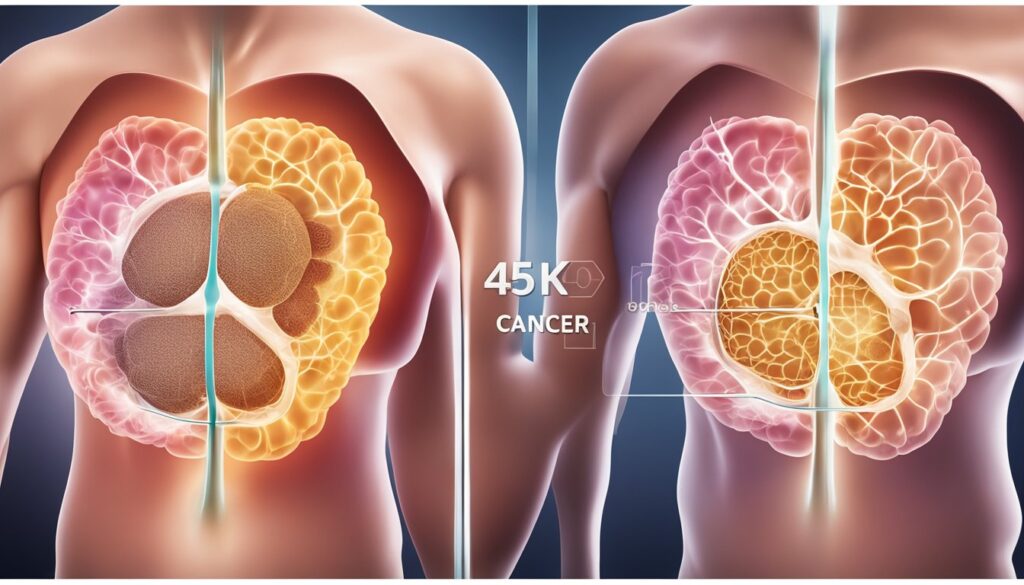Understanding the difference between fibrocystic breast changes and breast cancer is crucial for your health. Fibrocystic breast disease, a benign condition, is characterized by lumpy or ropelike breast tissue, often associated with pain and tenderness that fluctuate with the menstrual cycle. Many of you may experience these changes at some point, particularly those between 30 and 50 years old. This condition is directly influenced by hormones and does not increase your risk of breast cancer.

On the other hand, breast cancer presents a more serious health concern and is more commonly diagnosed in individuals over 50. It’s important to recognize that breast cancer may not always cause pain, which is why regular self-exams and screenings are essential. Painful lumps can sometimes reassure you, as pain is typically associated with benign fibrocystic changes rather than cancer. However, any new changes or lumps in your breast tissue should be evaluated by a healthcare professional to rule out cancer or other conditions.
To stay informed and proactive about your breast health, it’s imperative to understand symptoms, causes, and available treatments for both fibrocystic breast changes and breast cancer. While fibrocystic breast disease often doesn’t require treatment, understanding when to seek medical advice can ensure early detection and intervention for breast cancer, significantly impacting outcomes.
Understanding Fibrocystic Breast Disease

Expanding your knowledge of fibrocystic breast disease is crucial if you’re experiencing breast discomfort. This section clarifies what this condition entails, its commonality, the signs to watch for, and the role hormones play in its development.
Definition and Prevalence
Fibrocystic breast disease represents a range of benign breast changes. Rather than being a singular disease, it’s a term that describes a variety of symptoms, including cysts, fibrosis, and the general lumpiness of breast tissue. Fibrocystic changes are notably prevalent, affecting an estimated 50% of women at some point, particularly between the ages of 20 and 50.
Symptoms and Signs
When discussing symptoms, you may notice tenderness, swelling, or pain in your breasts, often fluctuating with your menstrual cycle. The tissue might feel lumpy or ropelike, mainly in the upper outer quadrants of your breasts.
- Cysts: Fluid-filled sacs ranging in size.
- Fibrous Tissue: More pronounced firm areas within the breast.
Hormonal Influences
Your menstrual cycle plays a pivotal role in fibrocystic breast changes. Reproductive hormones—specifically estrogen, progesterone, and androgens—can cause these tissues to react, leading to swelling and discomfort. Notably, such symptoms might lessen or disappear as you approach menopause, due to the decrease in hormonal activity.
Breast Anatomy and Changes
Understanding your breast anatomy aids in discerning normal changes from those warranting further attention. Your breasts are composed of lobules (milk-producing glands) and ducts (tubes that carry milk). Fibrocystic breasts often develop more prominent fibrous tissue, and the lobules can become cystic. These changes are typically benign, but you should monitor for any new developments or persistent symptoms.
Diagnosis, Treatment, and Management

Understanding the differences in diagnosis, treatment, and management for fibrocystic breast disease and breast cancer is crucial in guiding appropriate healthcare actions. This section outlines key steps and options for each stage of handling these distinct conditions.
Clinical Evaluation
Your healthcare provider will start with a thorough evaluation of breast symptoms which may include pain, lumpiness, and any nipple discharge or redness. Breast self-exams are also valuable for early detection of palpable breast mass. The presence of symptoms correlates with your menstrual cycle can often be indicative of fibrocystic changes rather than cancer.
Imaging and Biopsy
Imaging such as a mammogram or breast ultrasound is often used to assess breast tissue. If you have a breast lump or thickening, a diagnostic mammogram is utilized to focus on specific areas of concern. For more definitive analysis, a fine-needle aspiration or biopsy may be performed to distinguish simple cysts from solid masses.
Management Strategies
Once diagnosed with fibrocystic breast disease or breast cancer, management strategies will differ. For benign fibrocystic changes, wearing a soft, supportive bra such as a sports bra and applying over-the-counter pain relievers like acetaminophen (Tylenol) or NSAIDs (Advil, ibuprofen) can alleviate discomfort. In contrast, breast cancer management may include surgery, hormone therapy, tamoxifen, or other treatments as advised by your healthcare provider.
Lifestyle and Medications
Adjusting your lifestyle by reducing caffeine and alcohol, making dietary changes, and considering supplements such as evening primrose oil or vitamin E can be beneficial in managing symptoms of fibrocystic breasts. For breast cancer, medications and treatments are more complex, potentially including hormone therapy or chemotherapy, depending on the case. Always discuss the use of any medications or supplements with your healthcare provider to ensure they are safe and appropriate for your specific health needs.
Frequently Asked Questions

This section provides direct answers to commonly asked questions about Fibrocystic Breast Disease and distinguishes it from breast cancer, ensuring you have the most relevant information at your fingertips.
What are common treatments for Fibrocystic Breast Disease?
For treating Fibrocystic Breast Disease, over-the-counter pain relievers and supportive bras can alleviate discomfort. In some cases, hormone therapy may be recommended if symptoms are severe.
How can one manage symptoms of Fibrocystic Breast Disease through diet?
Modifying your diet by reducing caffeine and salt intake might help manage your symptoms. Some find relief by including more vitamin E and complex carbohydrates.
What distinguishes a complicated breast cyst from cancer?
A complicated breast cyst typically presents as painful and fluid-filled, and it often fluctuates with your menstrual cycle, whereas cancer is more likely to form a firm, painless mass that does not change over the cycle.
What are the typical symptoms associated with Fibrocystic Breast Disease?
Common symptoms include breast pain, tenderness, and lumpiness—especially in the upper, outer areas of your breasts. These symptoms may vary throughout your menstrual cycle.
Can a fibrocystic lump be an indication of breast cancer?
While a fibrocystic lump is usually benign and not linked to cancer, any persistent lumps should be evaluated by a healthcare professional. A biopsy can determine if a lump is malignant.
What does the typical ultrasound imaging reveal for fibrocystic breasts?
Ultrasound imaging can show that fibrocystic breasts have tissue that appears lumpy or ropelike in texture. This is considered normal for many women with these changes.